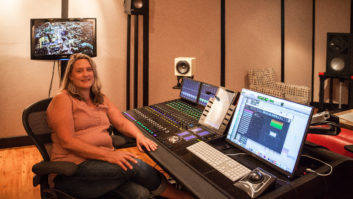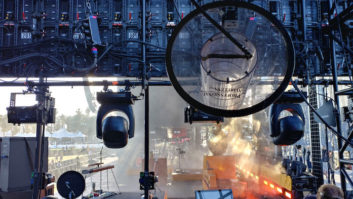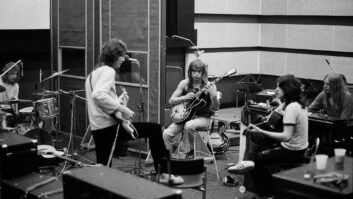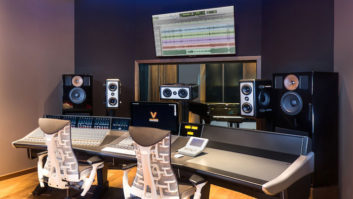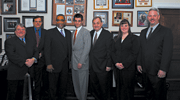

A not-so-funny thing happened on the way to this article. Last fall, while we were planning our issue topics for the 2007 year, we felt that a piece with wireless tips and techniques for location sound recording would dovetail nicely with this month’s NAB theme. But while we were doing our planning, there were some changes afoot that were well-intentioned but possibly devastating to wireless audio users.
The story starts a long time ago. Unlike what was done for other wireless apps — navigation, aeronautics, amateur radio, CB, cell phones, pagers, military, satellite, radio location, police, public safety and even taxis — the FCC never allocated any frequency band for pro audio use. Pro wireless simply existed by using unused broadcast channels or riding on the “white spaces” — easements used to prevent interference between the 6MHz-wide analog TV channels. Digital television (DTV) broadcasting is more exacting than analog TV, and channel frequencies can be butted against each other without guard bands. And with no need for these white spaces (especially after the February 2009 demise of analog TV), it has been assumed that these frequencies could be reallocated to other uses.
Among those meeting with the FCC in January 2007 to discuss pro audio’s concerns with upcoming legislation were (L-R): Richard Fitzgerald, Sound Associates; Bob Rendon, PRG Audio; Representative Bobby L. Rush; Geoff Shearing, Masque Sound; Paul Gallo, PAMA; attorney Danielle Burt; and Shure’s Jeff Krull.
BRING ON THE LEGISLATION
Currently, the FCC is considering legislation with two separate new bills from John Kerry (D-Mass.) and John Sununu (R-N.H.), which would allocate white spaces to wireless broadband devices. The plan is to open wireless Internet to vast new markets, especially in rural areas. “Instead of just talking about it, we need to make affordable broadband a reality everywhere,” says Kerry. The problem is that both the Kerry and Sununu bills recommend taking a huge swath of frequencies ranging from 54 to 698 MHz. In fact, this high-stakes game is already under way, with the cash-strapped FCC raising $13.7 billion last fall when players such as T-Mobile, MetroPCS, Sprint Nextel, Verizon, AT&T/Cingular and U.S. Cellular snapped up spectra in the 1,710 to 1,755MHz and 2,110 to 2,155MHz bands.
“It’s a real concern for our industry,” says Paul Gallo of the Professional Audio Manufacturer’s Alliance (PAMA), a group representing the interests of pro audio companies. “The key point here is recognizing the process: The government wants to move ahead with wider applications for broadband, and you can’t stop what is perceived to be good for the country.”
After meetings with leaders in the pro audio community, Representative Bobby L. Rush (D-Ill.) introduced H.R. 1320, The Interference Protection for Existing Television Band Devices Act of 2007, which requires unlicensed device manufacturers to demonstrate that their products will not interfere with existing white spaces products, including wireless microphone systems.
Shure president/CEO Sandy LaMantia described the Rush bill as “an astute and balanced approach to the so-called white spaces debate in Washington. It promises the continued development of new technologies without creating mass disruption in the production of major entertainment, religious, sports and news events.” The bill also suggests portable (mobile) unlicensed device use of the white spaces, but only after the fixed devices operate for three years without causing interference. In addition, portable device manufacturers must assure noninterference from their devices with thorough engineering analysis, design and testing.
“Our meetings with Rush have been about protecting legitimate pro audio wireless users, rather than trying to stop the expansion of wireless broadband,” adds Gallo. “This proposed legislation is the one that the audio industry could live with and we’re encouraging people to support his bill.”
CHANGES AFOOT
Even if the Rush bill passes, however, the net effect will be a loss of frequencies. “At best, the industry’s going to be severely limited by the amount of available spectrum and that’s going to change the way we do business,” predicts John Coffey of Coffey Sound, a major supplier of gear to location sound pros in Hollywood. “If you’re doing a reality show like The Apprentice, you may be using 50 to 60 radios, but the odds of getting 50 free frequencies that work together will be somewhere between slim and none. However, everybody looks at this situation differently. Some aren’t worried at all; others think we’re in deep trouble. I subscribe to the theory that’s somewhere in the middle: We’ll be able to use some of the stuff all the time, but we won’t be able to use everything all the time. And it will change as you move from location to location.”
There may be some validity in that approach, says Karl Winkler of wireless manufacturer Lectrosonics. “We’ve made some tests here where we scanned the entire spectrum and picked out a strong DTV broadcast signal. Setting our [wireless mic] transmitter to operate right in the middle of that, we walked 50 to 60 feet away where it worked fine and then started dropping out. So the range may be diminished, but it’s not as though it can’t be used. We do have to fight this and make sure the FCC understands what the impact will be, because there will be an impact: When you’ve got hundreds of channels coordinated at major events like the Grammy Awards or the Super Bowl, this change will cut down on the number of channels available. We know it’s gonna hurt, but as of today, we can’t say how much.”
The reallocating and crowding of available spectra will also bring changes in production. “One thing I’ve noticed is users in the field are reporting more problems these days, especially in certain areas of town where people just didn’t have RF problems before. Frequency coordination will become a new job that we didn’t have to deal with so much in the past,” Coffey predicts. “We’ll have motion picture companies or event coordinators sending people with scanners out on locations the day or the week before an event, searching for problems that could occur during the hours they’ll be shooting. We’re going to be looking at everything differently, with more contingencies and backup issues to deal with.”
There are other concerns, adds Professional Wireless Systems’ founder and top RF consultant, James Stoffo. “We’ve already kissed away about 60 to 65 percent of what we used to call the wireless mic bands to DTV, public safety, LANs, mobile radio — it’s all definitely gone in 2009. The saving grace would be if the analog [TV] stations opened up, but now wireless broadband over UHF wants those frequencies. People in our industry who own multiple wireless systems should be making noise about this. And let’s now forget the need for wireless com units backstage, which also impacts public safety. Someone could get killed or maimed backstage because they couldn’t hear a warning about a moving set piece. This is an important issue.”
However, there are rays of hope. “The presentations to the FCC from just the Broadway community alone — where there are 400 wireless channels in use along a single block of 46th Street in New York — brought a fresh dimension of thinking to the government,” Gallo reports. “Yet the pressures of the broadband group are enormous — these companies do more business in one day than our industry does in one year.”
Coffey adds, “Wireless radio companies need to be looking at other alternatives, such as removable bands that go across more spectrum spaces, and not just be in Block 21 but several blocks at one time. Even when you’re scanning for available frequencies, they might be clear one moment and gone the next. But technology always finds a way to catch up, and hopefully the manufacturers are working on ways to solve the problem with new ideas.”
IN THE TRENCHES
While Congress, the FCC, big-money telcoms and the pro audio community slug it out over the future of wireless frequencies, life goes on for tens of thousands of radio mic users throughout the country. Wireless technology keeps improving, but smaller budgets and more complex multi-camera shots make the job of the production sound mixer for location TV and film audio harder than ever. We talked to two top audio practitioners about working in today’s cluttered airwaves.

Joe Foglia at his setup for Scrubs
JOE FOGLIA (SCRUBS)
Joe Foglia began his audio career in more traditional recording, as the co-founder of the Artisan Recorders mobile unit, followed by 10 years behind the board at Miami’s Criteria Studios. Moving to film/TV work on shows such as Miami Vice, he eventually moved Westward, and has been the production sound mixer on NBC’s hit series Scrubs for six years.
Foglia’s sound cart is miles removed from the simple Nagra setup of a generation back. “I’m using the new Sonosax SX-ST mixer with its eight digital I/Os connected to a Zaxcom Deva V,” says Foglia, who is ever-concerned about the need for backups. “I record to four hard drives that I rotate so that you don’t put all your eggs in one basket. Then we pump out a DVD in UDF format. Parallel to that I run a 4-channel Sound Devices 744T.”
Production on Scrubs is anything but typical. “Our producer, Bill Lawrence [Spin City], wanted a facility where he could shoot, edit and do construction,” Foglia continues. “On Scrubs, we do everything in an abandoned hospital, which is a four-story building we’ve completely taken over. We rarely go out on location and shoot mostly within the hospital on the roof, first, second and fourth floors, with the third floor used mostly for production, makeup, hair, wardrobe and dressing rooms.”
Because the series is shot in a hospital, the ceilings are low, which means the sets lack the headroom that a soundstage would provide. “It’s hard to boom anything or follow a walk-and-talk,” laments Foglia, “but I had worked with ABC Sports and did a lot of golf, where I learned a lot of RF tricks, like using a balloon to raise RF antennas over the last nine holes of the course. On Scrubs, we had to adapt, so I came up with the idea of planting Lectrosonics 600 omnidirectional antennas throughout the whole hospital, and I run them through a combiner, so it’s all amplified. The actors can walk the entire length of the fourth floor without dropouts. That signal goes to the ‘A’ side of the diversity. The ‘B’ side gets a sharkfin directional that’s aimed at the main activity. We’ve never had any dropouts whatsoever.”
When using wireless, antenna performance is everything. “My normal antenna setup is an omnidirectional at one end and an array of sharkfin-types on the boom operator’s cart. That works pretty good for the [diversity’s] ‘A’ and ‘B’ sides,” Foglia says. “On occasion, I’ll pull out a PSC splitter/combiner so I can run four antennas over a large area if needed.
“My newest antenna addition — which few people use because they’re expensive [$1,000] — is the A5000CP dome antenna from Sennheiser. It works really well when I’m getting a lot of dropouts or problems from a nearby RF transmitter. It’s made of Lexan and is made to hang straight out or upside down facing downward. NBC uses a bunch of them on the outdoor sets for The Today Show and surround the set with those facing inward. I heard they worked like a dream, so I bought two. Not only do they provide long-distance pickup, but if you’re receiving hash on your sharkfin, you can often get a clean track by switching to the dome. It’s made specifically for Sennheiser wireless, but I’ve found it works on anything 450 MHz on up. It can also work as a transmission antenna. I carry a lot of antennas around, but this one’s my favorite.”
Other problems — even seemingly mundane ones — require creative solutions. “I encounter a lot of clothing noise when doing walk-and-talks, especially with actors wearing clothes underneath doctors’ jackets,” Foglia explains. “So I took all their stethoscopes, put a hole in the back of the tube and ran a Sanken COS-11 [miniature lavalier] down through each one with the cable end exiting at the other end. We call them ‘stethomics,’ and they sound great.”
Foglia has experienced increased RF problems in the packed airwaves in downtown Los Angeles and has found one possible answer. “What’s coming of age is the internal recorder. Memory is getting cheap and it’s great to back up all your wireless to a card. It would be great if we could run these all day, but a lot of actors don’t want to wear a pack if there’s a boom mic on the shot. You’re trying to do a backup, but you’re constantly explaining the concept. It’s a tough trade-off.”
MATHEW PRICE (THE SOPRANOS)
Mathew Price has numerous Emmy and C.A.S. Award nominations (and a 2000 C.A.S. win) for his work on The Sopranos, a show he’s been with since its 1997 pilot. We caught up with Price in late-February, as he was working on the series’ final episoode.

Mathew Price on location for The Sopranos
Price’s recording chain includes a Zaxcom Deva II. “I love nonlinear recording,” he says. “I never bought a DAT machine because it didn’t make sense to have a linear digital recorder once you’re working in digital. I’ve been using a Nagra IV-S for backup, but now that Quantegy has discontinued analog tape, I’m looking to upgrade to either the Sound Devices 744T or to the Deva V, with my Deva II as the backup.
“There’s rarely a day when we don’t use radio mics on actors,” Price continues. “And my boom op, Paul Koronkiewicz, is almost always radio’d, mostly for convenience and mobility. I’ve been using Audio Limited’s 2000 Series for a while. I have up to eight radio mics available, although I don’t like to wire people more than I have to. I’m still mixed about the whole multitrack thing — a lot of post-production people don’t want to have to sift through eight tracks of audio to find what they need, although I can see the advantages of it.
“I didn’t get into this industry to be a recordist — I really like mixing. And picture editors don’t have a lot of iso’d tracks; they’re working with your mono dialog mix when they’re doing the preliminary sound edit. Although when the audio people start working with it in post, it’s nice for them to go back later and pull up separate radio mics.”
Asked about his favorite lavaliers, “I mostly use Sonotrims. My utility/second boom, Timothia Sellers, prefers them because they lie flat, are easy to hide and have an open sound that blends well with my Neumann KMR-81 shotguns. One of my favorite mics is the Sanken CUB-01, the little boundary mic. We use that everywhere, especially in cars or on tabletops. They don’t sound quite like the Schoeps boundary, but they cost a third as much and are so light they’ll stick to anything with a bit of Topstick double-sided tape.”
A big factor in effective wireless reception comes down to antenna placement and getting it “as close as you can — or you can outboard the antenna and run it up a pole with a cable to get it closer to the actors. I usually work with just dipole — bidirectional — antennas,” Price explains. “I have a little tree with four of these mounted — two for each of my systems — and they work pretty well. I’ll use a directional sharkfin antenna when needed. We’re kind of lucky with The Sopranos since most of it is shot in New Jersey, so interference is less of an issue than when we work in Manhattan. Part of the secret of antennas is keeping a line of sight to the transmitters. These little things can make a huge difference. The human body will absorb a fair amount of RF, and we sometimes do walk tests with transmitters and they’re fine until you put them on somebody and lose part of your reception.”
Ironically, wireless mics are occasionally the key to an interference-free take, says Price. “We’ve shot a lot of scenes at the internationally known Bada Bing strip club and it’s located next to a TV tower. We’ve found that you can’t run boom cable there — even with my five-wire Canare Quad cable, which is about as good as you can get in terms of reducing interference. In this location, any mic cable acted as an antenna, but when we go wireless, there’s no problem.”
At least for now, the analog vs. digital wireless issue seems moot. “It’s all secondary to having something that works — however it works,” Price says. “The technology has gotten fairly reliable, even in rough situations. I have an older system, but most people get by running very frequency-agile systems, and within that range, you can usually find something workable. My eight systems are split evenly between two diffferent [frequency] blocks, so if I have problems on one, I can go to the other. I did a scene last year near the Empire State Building and it was rough — we had a lot of radio mic hits. Here’s where that Zaxcom recording wireless [TRX-901] would have solved the problem. Being able to record right on the transmitter is a phenomenal, face-saving technology. It may be just the answer. No one wants to ask for an extra take due to RF problems and multitrack won’t necessarily save you there.
“For me, the biggest issue is the frequency squeeze: It’s a dire situation. We’re outnumbered and out-gunned.”

Link to Document
A guide to RF frequencies in the U.S.
George Petersen is Mix’s executive editor.

